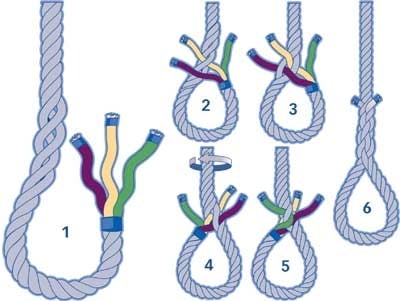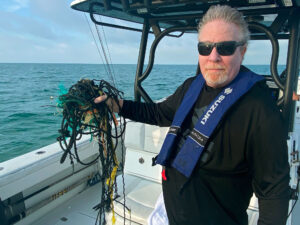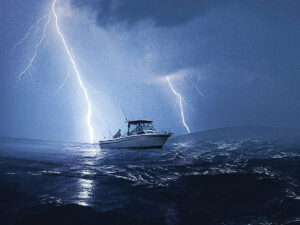
Weekend Workbook
It’s easy to purchase dock lines that have been already made up or a prepackaged anchor rode complete with chain. But I find it satisfying to spend a quiet evening making ones that will fit my boat and are done the way I like. It’s rare that those dock-lines-in-a-bag are the perfect length. They’re either too short or so long you wind up with a messy coil on the dock. Store-bought anchor rodes are the same; it’s unlikely that the included chain is right for your boat, anchor, and where you’ll drop the hook. Making up these lines is simple; it’s also a seaman’s art that every boater worth his salt should know. The examples here are for 1/2″ line because that’s the most common size. The minimum for any boat is 3/8″, as anything less is hard to grip.
CUTTING A LINE: Slip a 1 1/2″ length of 1″ heat-shrink tubing down the line to where the cut is to be. Apply heat so tubing contracts tightly around the line. Cut at the midpoint of the tubing. Seal ends with a butane lighter or heat gun to prevent unraveling. Use tape instead of tubing for ends with eye splices.
MAKING AN EYE SPLICE:
| Parts | Supplies |
| • Three-strand 1/2″ nylon rope • High-test/40-grade chain • 1/2″ galvanized thimble • 5/16″ galvanized shackle • 5/16″ swivel | • Knife • Masking tape • Butane lighter or heat gun • 1″ heat-shrink tubing • Monel seizing wire |
Wrap a strip of tape around the line 6″ from the rope’s end. Separate the three strands, taping their ends so they won’t come apart. Of these three strands, one will be uppermost and in the center of the other two. This is your starting strand (yellow). Tuck it under the uppermost strand of the standing part of the rope. The tuck is made “against the lay,” from right to left. Tuck the left-hand strand (red) under the next strand up on the standing part and over the yellow strand. Then flip the eye over and tuck in the remaining strand (green), still working from right to left. After the first three tucks, check what you’ve done. If the strands emerge symmetrically from the standing part, each coming out from under a different standing strand, you have it right. Complete the splice by pulling the first tucks tight, then adding four more tucks done in the same sequence as the first. When finished, cut off the strands and heat seal the projecting ends to 3/8″.
Anchor Rodes
The typical rode is made from three-strand nylon line that has an eye splice around a galvanized steel thimble at one end. The chain, with a link diameter of half the rope’s diameter, is attached to the thimble with a galvanized shackle one size larger than the chain. The anchor is attached to the chain with a swivel one size larger than the chain. The shackle’s and swivel’s threaded pins should be coated with grease to keep them from seizing. Use Monel or stainless-steel wire to keep the pin from unscrewing.
| LOA | Rope | Chain |
| Up to 25′ | 160′ (3/8″) | 10′ (1/4″) |
| Up to 35′ | 240′ (1/2″) | 15′ (1/4″) |
| Up to 45′ | 300′ (5/8″) | 20′ (5/16″) |
| Up to 55′ | 380′ (3/4″) | 20′ (3/8″) |
| (for average boat, 7:1 scope) |
ROPE-TO-CHAIN SPLICE: Most windlasses won’t accept rodes with a bulky thimble and shackle. The connection between rope and chain must be smooth and seamless. Tape the line 1’6″ from the end. Unlay the rope and tape the end of each strand. Pass two strands through the last link of the chain from left to right. Slip a 1″ length of heat-shrink tubing (to reduce chafing) over the two strands and slide it halfway through the link. Pass the remaining strand through the heat-shrink tubing from right to left. Snug up the strands against the link and apply heat to the tubing. From here on, follow the instructions for making an eye splice.
DOCK LINES
| EYE: The eye (at one end only) should be at least 1′ long when stretched out. Don’t include the eye when measuring line length. | NUMBER: The minimum is two bow/stern lines and two spring lines. Two extra spring lines would be helpful and can be joined for emergency towing. | LENGTH: Bow and stern lines should be 2?3 of your boat’s length; spring lines equal 11?2 times the boat’s length. Add 1’6″ for the eye splice before you cut. | DIAMETER: Use the above Anchor Rodes chart as your guide. Heavy boats, or ones with great windage, move up to the next larger line. | MATERIAL: As with anchor rodes, three-strand nylon has the greatest stretch for shock absorption and is easy to splice. |









